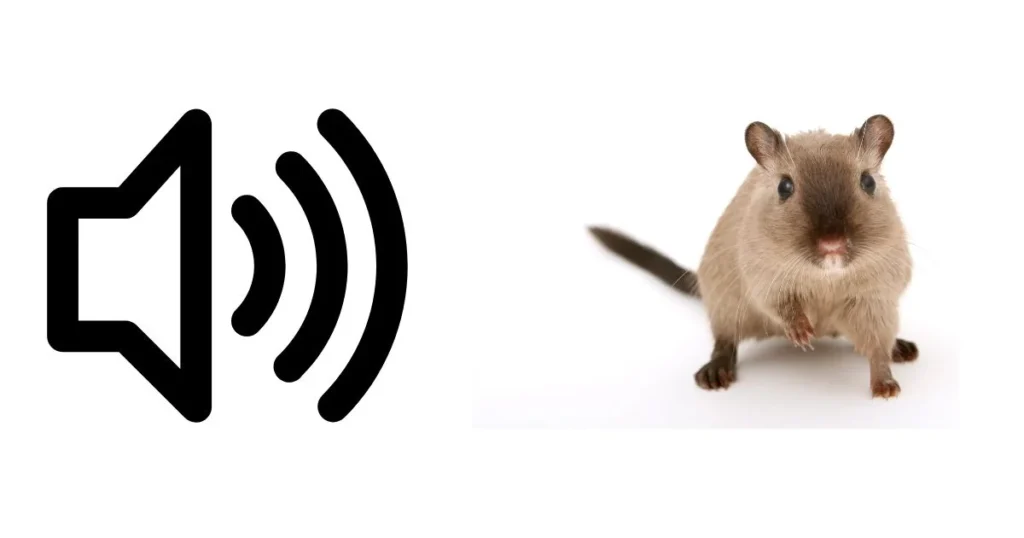
Mouse are small, nocturnal rodents that are known for their high-pitched squeaks and chirps. These sounds are a crucial part of their communication and have a significant impact on their social interactions.. Understanding the different types of sounds that mouse make can offer valuable observations regarding their actions and assist in pest management endeavors.
One of the most common sounds that Mouse make is a high-pitched squeak. This sound is often used by young mice to call out to their mothers and by adult mice as an alarm to notify others of potential hazards. Mouse also produces a variety of other vocalizations, including chirps, trills, and clicks, which are often used to communicate different messages to other mice.
In addition to vocalizations, mouse also produce a range of non-vocal sounds, such as scratching and gnawing. These sounds are produced when mice are digging through food or nesting materials and can be a sign of a rodent infestation. By understanding the different types of sounds that mouse make, homeowners and pest control professionals can identify and address mouse problem before they become an infestation in the attic, walls, or inside a property.

Mice are social animals that use various forms of communication to interact with other mice. Understanding these communication methods can provide valuable insight into their behavior and social structure.
Mouse use a variety of vocalizations to communicate with each other, including squeaks, chirps, and ultrasonic sounds. These vocalizations can convey information about a mouse's emotional state, such as fear or aggression, as well as their social status within a group.
Male mice emit ultrasonic vocalizations to attract females during mating season. Female mice use vocalizations to communicate with their offspring and establish social bonds with other females.
The frequency and pitch of scratching sounds can also provide important information about their behavior. High-pitched vocalizations are often associated with fear or distress, while lower-pitched sounds may indicate aggression or dominance.
Researchers have also found that mouse uses a form of "musical body language" to communicate with each other. By varying the pitch and timing of their vocalizations, mouse can create complex patterns that convey specific messages to other mouse.
In conclusion, mice use a variety of vocalizations and sounds to communicate with each other. By understanding these communication methods, researchers can gain valuable insights into their behavior, social structure, and how the express emotions.
Mouse are highly sensitive to sound and use it as a means of communication and navigation. They emit a variety of sounds that range from high-pitched squeaks to low-frequency vibrations. In addition to their own sounds, they are also affected by external sounds in their environment. This section will explore the effects of sound on mice, including the effects of loud noises and the use of sound as a repellent.
Loud sounds can greatly affect rodents. Research indicates that being exposed to loud noises can induce stress, anxiety, and even physical harm to rodents. Loud noises mice can also disrupt their natural behavior patterns, such as feeding and mating. In some cases, loud noises can even scare mice away from their nests, which can lead to a disruption in their social structure.
Sound can also be used as a means of repelling rodents. Specific sound frequencies have been discovered to be especially efficient in repelling rodents from entering a particular area. These sounds are typically high-pitched and unpleasant to rodents, and they can be emitted from a variety of devices, including ultrasonic pest control devices.
While the effectiveness of sound as a repellent is still a topic of debate, many people have reported success in using these devices with loud sound that keeps mice away. It's crucial to mention, though, that these devices should be employed alongside other pest management strategies, like seal entry points and eliminating food sources.
In conclusion, sound plays a significant role in the lives of rodents and can have both positive and negative effects on their behavior. While loud noises mice can cause stress and disrupt their natural behavior patterns, certain frequencies of sound can be used as a means of repelling rodents.

Rodents are recognized for their acute hearing ability and are drawn to specific sounds. By using the right sounds, it is possible to lure mice into a specific area. In this section, we will explore some of the ways to attract mice using sounds.
One way to attract mice is by mimicking their vocalizations. Rodents use a variety of vocalizations to communicate with each other, including squeaks, chirps, and ultrasonic sounds that are beyond the range of human hearing. By playing these sounds, it is possible to create an environment that is attractive to mice.
There are a variety of devices available that are designed to emit mouse vocalizations. These devices can be used in areas where mice are known to be present, such as in barns or sheds. By playing these sounds, it is possible to create an environment that is attractive to mice and encourage them to move into the area.
It is important to note that while mimicking mouse vocalizations can be effective in attracting these creatures, it is not a foolproof method. Other elements, like the presence of food and shelter, can also influence mice attraction. Furthermore, it's crucial to implement measures to deter mice from accessing unwanted areas, such as residences or commercial establishments.
Overall, using mouse vocalizations to attract rat and mouse, can be an effective method for controlling populations in certain areas. However, it is important to use caution and take appropriate steps to prevent these creatures from becoming an active nuisance.

Mice are known for their ability to produce and perceive ultrasonic sounds, which are high-frequency sounds that are beyond the range of human hearing. These sounds are a crucial aspect of their communication and can serve various functions, including socializing, mating, and navigation.
Mice produce a wide range of ultrasonic vocalizations, which can vary in frequency depending on duration, and intensity. Some of the most common sounds include squeaks, trills, and chirps, which are used for social communication and can convey information about the mouse's emotional state, dominance status, and reproductive readiness.
In addition to vocalizations, rat and mouse also use ultrasonic sounds for echolocation, which is a form of navigation that entails emitting sounds and then listening for echoes to discern the location of objects in their surroundings. This ability is particularly important for nocturnal species that need to navigate in the dark and avoid predators.
Overall, the ability to produce and perceive ultrasonic sounds is a crucial aspect of a mouse's sensory repertoire, and is pivotal for their survival and reproductive success. By comprehending the purpose and importance of these sounds, researchers can glean valuable insights into the behavior and ecology of these intriguing creatures.
Electronic devices for mice control have become increasingly popular in recent years. These devices function by emitting high-frequency sound waves that mice and other rodents find unpleasant. The noise waves are typically inaudible to humans and pets, making them safe and effective to repel these pesky pests.
There are several types of electronic devices available on the market, including ultrasonic repellers and electromagnetic repellers. Ultrasonic repellers emit high-frequency sound waves that are designed to repel mice, while electromagnetic repellers utilize electromagnetic fields to generate an environment that is inhospitable for mice.
While electronic devices can be effective at repelling mice, it's important to acknowledge that they are not a foolproof solution. Some mice may be able to adapt to the background noise waves and continue to live in the area. Additionally, electronic devices may not be effective in large infestations or in areas with a lot of clutter.
Overall, electronic devices can be a useful tool in the fight against mice and other pests. They are safe, user-friendly, and can serve as an efficient method to keep your home or business rodent-free.

Mice are highly sensitive to sounds and can respond to them in various ways. In their natural environments, mice use sounds to communicate with each other, locate food, and detect predators. They possess outstanding hearing abilities and can perceive sounds within a frequency range of 1 kHz to 100 kHz.
When mice hear a sound, they may freeze or become still to assess the situation. This behavior is known as "freezing response" and is a common response to potential threats. If the noise continues, mice may start to investigate the source of the sound by moving towards it cautiously.
Mice also use sound like communication with each other. They produce ultrasonic vocalizations that are too high-pitched for humans to hear. These vocalizations can communicate various information, such as territorial boundaries, mating calls, and distress signals.
In addition to vocalizations, mice also produce sounds by scratching, gnawing, and running. These sounds can provide important cues about the presence of mice in an area. For example, if you hear scratching sounds may indicate that mice are looking for nesting material in the attic or searching for food.
Overall, mice have a complex and sophisticated response to sounds in their natural environments. By comprehending their behavior, we can acquire insights into their ecology and formulate effective strategies for population management.
One effective way to prevent rodent infestation is by integrating sound into pest management. This involves using ultrasonic devices that emit high-frequency sounds that are unpleasant to mice. These devices are crafted to be inserted into electrical outlets and emit sound like waves that are inaudible to humans but can disrupt the communication and navigation systems of mice. This can make it difficult for them to find food, water, and shelter, ultimately discouraging them from staying in the area.
It's essential to recognize that while ultrasonic devices can be effective, they shouldn't be relied upon as the sole method of pest control. They should be employed alongside other preventive measures, like seal entry points and storing food in sealed containers, and maintaining a clean environment.
When using ultrasonic devices, it is important to place them strategically throughout the area. They should be placed in areas where mice are likely to travel, such as near entry points, along walls, and in areas where food and water are stored. It's also important to acknowledge that these devices have a limited range, so multiple devices may be necessary in larger areas.
In addition to ultrasonic devices, there are other sound-based strategies that can be utilized to prevent infestations of mice. For example, some homeowners have found success in using white noise machines to disrupt the communication and navigation systems of mice. Others have used recordings of natural predators, such as cats and owls, to deter mice from entering the area.
Overall, integrating sound scratching into pest management can be an effective way to prevent mice infestations. However, it should be employed alongside other preventive measures and should not be relied upon as the sole method of pest control. With the right combination of strategies, homeowners can effectively deter mice from entering their homes and causing property damage in walls, attics, and other common places.
When it comes to controlling mice infestations, it's important to contemplate the ethical ramifications of the methods employed. While some methods such as poison and glue traps may be effective, they can also be inhumane and cause unnecessary suffering to the mice.
One alternative to traps approach that has become popular in recent years is the use of sound to repel mice. This method involves emitting high-frequency sound waves that are unpleasant to mice but humans can't hear them. This approach is considered more humane and has been shown to be effective in deterring mice from entering a space.
It is important to note that while sound may be a more humane method of pest control, it is not a foolproof solution. Mice may grow accustomed to the sound over time, and the effectiveness of the method may decrease. Additionally, it is important to ensure that the sound is not causing any harm to other animals in the area. Always consider combining different methods, like traps, sound repellents, and natural deterrents.
If you are experiencing a mouse infestation, it is important to take action to address the issue. However, it is equally important to do so in a humane and ethical manner.
If you are tired of trying to repel mice, maybe is time to let experts handle the situation. Contacting Critter Stop for assistance with your mouse infestation can ensure that the problem is addressed in a way that is both effective and ethical. Prevent health risks, call us at (214) 234-2616 to get your property free of mice!
Mice are generally afraid of loud and sudden noises. They have a very sensitive hearing and can hear high-frequency sounds that are inaudible to humans. Ultrasonic sounds, such as those produced by electronic pest control devices, can scare mice. However, it is important to note that these devices are not always effective and may only provide short-term relief.
Yes, noises can scare mice. As mentioned earlier, they are sensitive to loud and sudden sounds. However, it's important to recognize that mice can become accustomed to noises over time. For example, if a mouse is exposed to a constant noise, such as a refrigerator humming, it may eventually become desensitized to it.
Mice are most active at night, so homeowners may hear scratching or scurrying noises in the walls or ceilings. They may also hear squeaking or chattering noises, which are typically made by mice communicating with each other. Additionally, homeowners may hear gnawing or chewing noises as mice are known to chew on wires and other materials. It is important to address any of these noises promptly to prevent a potential infestation.
Visit our Critter Library and learn more about our furry friends